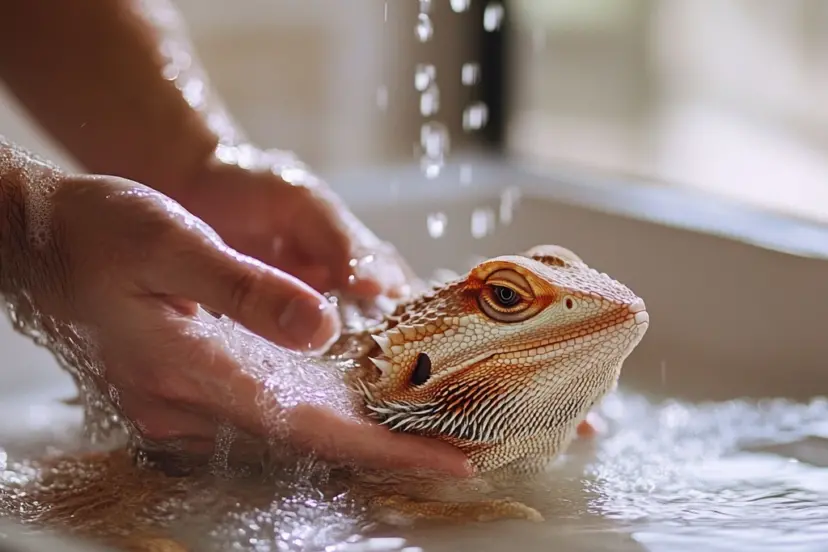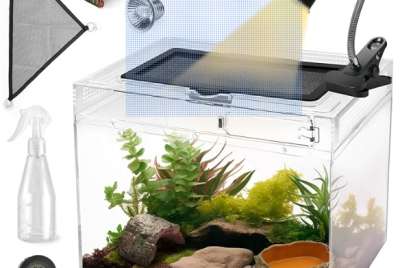Bathing a Bearded Dragon: A Complete Care Guide
Bathing a bearded dragon is a vital part of their care routine, ensuring they stay healthy, hydrated, and clean. If you’re new to owning a bearded dragon, you may be unsure of how to bathe them properly. In this guide, I’ll walk you through the benefits, the steps to follow, and some tips to make bath time a positive experience for your scaly friend.
Why Bathing Your Bearded Dragon Is Important
While bearded dragons are desert creatures, they still require regular baths to stay clean, hydrated, and aid in the shedding process. Bathing also helps keep their skin in good condition and prevents any buildup of dirt or bacteria. Whether your bearded dragon loves or hates bath time, it’s an essential part of their care.
Benefits of Bathing a Bearded Dragon
There are several important benefits that come with bathing your bearded dragon, from promoting hydration to supporting their shedding cycle.
Hydration and Moisture
Even though bearded dragons drink water, they often absorb moisture through their skin during baths. This additional hydration is particularly beneficial in preventing dehydration, especially if your dragon doesn’t drink regularly from a water bowl.
Aids in Shedding
Baths are a great way to help bearded dragons shed their skin. Warm water softens the old skin, making it easier for your dragon to shed naturally without complications. This is particularly important for young dragons, who shed frequently as they grow.
Cleaning and Hygiene
Bearded dragons can sometimes get dirty from food, substrate, or their own waste. Bathing helps keep them clean, preventing bacteria from accumulating on their scales. Additionally, a regular bath routine can help reduce the risk of parasites and infections.
How Often Should You Bathe Your Bearded Dragon?
The frequency of bathing depends on several factors, such as the dragon’s age, activity level, and current health.
Factors That Influence Bath Frequency
Younger dragons tend to need more frequent baths as they are more active and shed more often. Dragons living in dry environments may also benefit from more regular bathing to help with hydration.
General Guidelines for Different Age Groups
- Baby and Juvenile Bearded Dragons: Bathe 3-4 times per week, as they are still growing and shedding frequently.
- Adult Bearded Dragons: Bathe 1-2 times per week, depending on their activity level and shedding cycle.
- Older or Sick Dragons: You may need to bathe them more frequently to help with hydration, especially if they are not drinking water on their own.
Preparing for Bath Time
Before you start, make sure you’ve set everything up for a smooth and stress-free bath.
Water Temperature: What’s Ideal?
The water temperature should be warm but not hot—around 85-92°F (29-33°C) is perfect. You can use a thermometer to check the water temperature, ensuring it’s comfortable for your dragon.
Choosing the Right Bathing Container
Choose a container that’s shallow and large enough for your bearded dragon to sit comfortably without being fully submerged. A plastic tub, a sink, or even a small bathtub can work, but always ensure the water level is shallow enough to avoid the risk of drowning.
What You’ll Need Before You Start
Have the following items ready:
- A soft towel for drying
- A container of warm water
- A thermometer to check water temperature
- Optional: a soft brush to gently clean your dragon if necessary
Step-by-Step Guide to Bathing Your Bearded Dragon
Now that you’re ready, let’s dive into the steps for giving your bearded dragon a proper bath.
Step 1: Preparing the Bath
Fill the bath container with warm water. Make sure the water is no deeper than your dragon’s shoulders. For younger or smaller dragons, keep the water even shallower.
Step 2: Gently Introducing Your Bearded Dragon to the Water
Slowly place your bearded dragon into the water, allowing them to adjust to the temperature. Let them sit in the water, making sure they are calm. Some dragons will relax and enjoy the bath, while others may need a little more encouragement.
Step 3: Monitoring and Encouraging Comfort
Stay close and gently pour some water over your dragon’s back using a small cup or your hand. This can help them get used to the sensation. Keep an eye on them to ensure they are comfortable and not stressed.
Step 4: Drying Your Bearded Dragon Properly
After about 10-20 minutes in the water, lift your dragon out and place them on a soft towel. Gently pat them dry, paying extra attention to areas like their tail and underarms to prevent any leftover moisture that could cause irritation or fungus.
Safety Tips for Bathing Your Bearded Dragon
Bath time should always be safe and stress-free for your bearded dragon. Here are some essential safety tips to keep in mind.
Supervision and Handling
Never leave your bearded dragon unattended in the water. Even if the water is shallow, accidents can happen, so it’s crucial to supervise them throughout the entire bath.
Avoiding Over-Immersion
Don’t immerse your bearded dragon’s head or body fully in the water. They can easily inhale water, which could lead to respiratory infections or drowning.
What to Do if Your Bearded Dragon Is Afraid of Baths
Not every bearded dragon will take to bath time right away. If your dragon seems anxious or afraid, there are ways to help them feel more comfortable.
Gradual Introduction to Bathing
Start by introducing your dragon to the bath slowly. You can begin with short sessions of a few minutes and gradually increase the time as they become more comfortable.
Making Bath Time a Positive Experience
Offer your bearded dragon their favorite treats before and after bath time. This helps create positive associations with the bath and reduces their anxiety over time.
What Not to Do When Bathing Your Bearded Dragon
There are a few things you should avoid when it comes to bathing your dragon.
Avoid Using Soaps or Chemicals
Never use soap, shampoo, or any chemicals when bathing your dragon. These can be harmful and may irritate their sensitive skin or eyes.
Avoid High Water Levels
Keep the water shallow—just enough to cover your dragon’s legs. High water levels increase the risk of drowning and can make your dragon feel stressed.
Post-Bath Care: Drying and Rehydration
After the bath, it’s important to take care of your dragon’s post-bath needs.
Towel Drying: Keeping Them Warm
After drying them with a soft towel, place your dragon in their basking area to ensure they warm up properly and finish drying. This is important for regulating their body temperature after being in cooler water.
Offering Hydration After the Bath
Even though your dragon may have absorbed water during the bath, always offer fresh drinking water afterward. Hydration is key to keeping them healthy, especially in warmer environments.
Conclusion: The Key to Happy, Healthy Bearded Dragons
Bathing your bearded dragon is more than just a cleaning routine—it’s an opportunity to support their hydration, aid in shedding, and bond with them. With the right approach and a gentle touch, bath time can become a positive, beneficial experience for your dragon. By following these simple steps, you’ll keep your dragon clean, healthy, and happy, ensuring they thrive in your care for years to come.
FAQs
- How often should I bathe my bearded dragon?
The ideal frequency depends on age and health. Juveniles may need baths 3-4 times a week, while adults do well with 1-2 weekly baths. - What is the best water temperature for bathing a bearded dragon?
The water should be warm, between 85-92°F (29-33°C), ensuring it’s comfortable and safe for your dragon. - Can I use soap when bathing my bearded dragon?
No, never use soap or chemicals. Water alone is enough to clean your bearded dragon safely. - Why does my bearded dragon hate baths?
Some dragons may feel uncomfortable with water at first. Gradually introduce them to baths and make the experience positive by keeping the water shallow and warm. - What should I do if my bearded dragon poops in the bath?
This is common. Simply remove your dragon from the water, clean the container, and refill it with fresh, warm water.
By making bath time stress-free and following these guidelines, you’ll ensure your bearded dragon remains healthy and happy!




